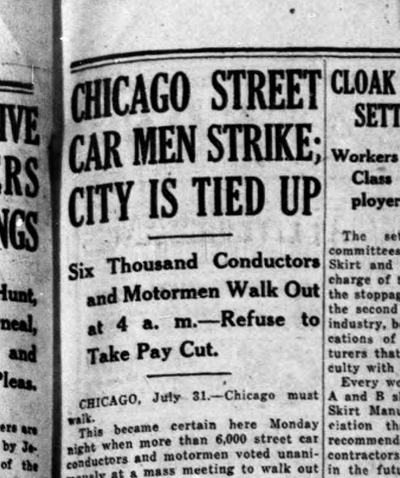Susan Rubenstein DeMasi
“Chicago Streetcar Men Strike” “Evicted Miners Seek Shelter in Tents” “Port Workers Plan Big Union” “Strikers Expect Full Rights Back” “Labor Council Aids Garment Workers” While conducting research for the biography I’m writing I’ve come across a treasure trove of historical artifacts that relate to labor union history. The above headlines represent just a few of the newspaper articles from one day in 1922. News of walkouts, settlements, assaults on strikers and even internal union disputes were covered. The sheer number of articles that made the papers in the early 20th century is surprising. Union membership was still climbing, and the many newspapers and magazines (the number of newspapers in existence today is exponentially smaller than 100 years ago) provided their readers with news that directly affected them. There were more than a few papers specifically dedicated to labor news. While not all articles were impartial in either the mainstream or the partisan publications—passions ran high both for and against labor—the fact that unions were part of the everyday landscape made for a vibrant national dialogue. Of course one exciting research find always leads to another. (Sometimes it’s hard to stop following a research trail. Stop me before I hurt myself!) Along the path I’ve also come upon a number of labor history archives that have captivated me and fueled my continuing interest in labor history. The Labor and Working-Class History Association offers the latest news as well as union activists’ biographies, action alerts and teaching resources. Its links to historical documents—including U.S. Senate transcripts of hearings investigating strikes, oral histories from early union members, political cartoons and reprints of newspaper articles—are reminders of the hard times that our forebears lived through. The New York Labor History Association is another great resource to put you in touch with the movement’s rich past. Their newsletter “Work History News” is available on the website and helps readers keep apprised of current and past events. While these websites are informative, it’s still fun to look directly at the source. Your libraries (public and the college) provide access to historical newspaper databases such as The New York Times (going back to 1851) and the Brooklyn Daily Eagle (back to 1841.) The free website Fulton County Historical Society has hundreds of old newspapers, including the New York Call, a socialist newspaper that reported heavily on labor news. Users can search through the front pages of more than a thousand newspapers at the Library of Congress’ Chronicling America Historical American Newspapers database. Digitized newspapers, ranging from small-town gazettes like the Tombstone Prospector to big city newspapers like the New York Tribune provide a glimpse into history from 1836 through 1922. Thanks to library digitization projects you can count on the headlines of yesteryear, including those concerning labor history, surviving in virtual repositories. |
